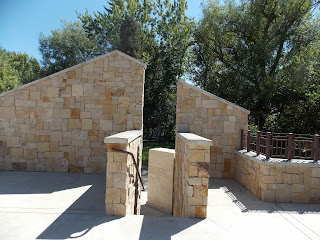The centerpiece is a life-size bronze statue of Anne Frank pulling back an imaginary curtain, one hand is behind her back and holding her diary. If you follow the direction of her gaze, it seems that she is looking at a tree. She mentions this tree in her diary. A sapling from the actual chestnut tree in Amsterdam has been planted in this garden.
Behind the statue of Ann Frank is a space marked out showing the amount of cramped space she and her family had to live in for two years. I believe it was a total of seven people. Beyond that space is a steep staircase which, at the time, was hidden by a bookcase.
The large stone wall behind the bookcase is part of a series of walls reminiscent of Amsterdam.
On the stone bookcase are quotations from Ann's diary, as shown above. Also in the memorial is an 180 foot quotation wall. Here are statements from presidents to slaves. People who survived the holocaust, as well as the Japanese who suffered interment here during World War 11, and Native Americans. All have a common voice decrying the loss of human rights and dignity.
There should be a memorial of this kind in every city of our nation. It left me feeling more stronger than ever that we should not let our government lead us down paths which build walls, restrict immigrants fleeing poverty and war, or deny health, food or education to its own people.






No comments:
Post a Comment